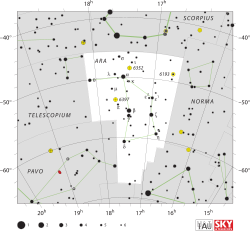Star in the constellation Ara
Rho1 Arae is the Bayer designation for a star in the southern constellation of Ara . Unusually for a star with a Bayer designation , it was not catalogued by Bayer in his Uranometria Nicolas Lacaille , in his Coelum Australe Stelliferum published in 1763. This star gained the Bayer designation of Rho1 Arae in Bode 's Uranographia 1 Arae is one of the dimmest stars with a Bayer designation, having an apparent visual magnitude of just +6.275[ 2] Bortle Dark-Sky Scale , this means the star is just barely visible to the naked eye in dark rural skies. Based upon parallax measurements, it is about 640 light-years (200 parsecs ) distant from the Sun , give or take a 50-light-year margin of error .[ 1]
A light curve for V846 Arae, plotted from TESS [ 12] The Hipparcos 1 Arae is a variable star . It was given its variable star designation , V846 Arae, in 1999.[ 13] spectroscopic binary system, which means that the presence of an orbiting companion is indicated by shifts in the spectrum .
The primary star is a Be star , while the secondary star is a subdwarf O star ; they orbit each other with a period of about 236.50 days.[ 5] stellar classification of B3 Vnpe, which may indicate the primary is a B-type main-sequence star . The 'e' suffix indicates the presence of emission lines from the primary Be star. For Rho1 Arae, the emission lines are prominent and variable.[ 9] projected rotational velocity of 370 ± 10 , which makes it difficult to obtain reliable orbital elements .[ 9]
Rho1 Arae has a peculiar velocity of 27.4 ± 4.9 km/s relative to its neighbors,[ 10] runaway star system. A scenario that it was ejected from the Scorpius–Centaurus OB association as a result of a past supernova explosion seems unlikely because of its binarity.[ 9]
References
^ a b c d e f van Leeuwen, F. (November 2007), "Validation of the new Hipparcos reduction", Astronomy and Astrophysics , 474 (2): 653– 664, arXiv :0708.1752 Bibcode :2007A&A...474..653V , doi :10.1051/0004-6361:20078357 , S2CID 18759600 . ^ a b c d Kozok, J. R. (September 1985), "Photometric observations of emission B-stars in the southern Milky Way", Astronomy and Astrophysics Supplement Series , 61 : 387– 405, Bibcode :1985A&AS...61..387K . ^ Evans, D. S. (June 20–24, 1966), "The Revision of the General Catalogue of Radial Velocities", in Batten, Alan Henry; Heard, John Frederick (eds.), Determination of Radial Velocities and their Applications, Proceedings from IAU Symposium no. 30 , vol. 30, University of Toronto: International Astronomical Union , p. 57, Bibcode :1967IAUS...30...57E . ^ Anderson, E.; Francis, Ch. (2012), "XHIP: An extended hipparcos compilation", Astronomy Letters , 38 (5): 331, arXiv :1108.4971 Bibcode :2012AstL...38..331A , doi :10.1134/S1063773712050015 , S2CID 119257644 . ^ a b c d Wang, Luqian; Gies, Douglas R.; Peters, Geraldine J.; Han, Zhanwen (April 2023). "The Orbital and Physical Properties of Five Southern Be+sdO Binary Systems" . The Astronomical Journal . 165 (5): 203. arXiv :2303.12616 Bibcode :2023AJ....165..203W . doi :10.3847/1538-3881/acc6ca ISSN 1538-3881 . ^ a b c d Wang, Luqian; Gies, Douglas R.; Peters, Geraldine J.; Götberg, Ylva; Chojnowski, S. Drew; Lester, Kathryn V.; Howell, Steve B. (2021). "The Detection and Characterization of Be+sdO Binaries from HST/STIS FUV Spectroscopy" . The Astronomical Journal . 161 (5): 248. arXiv :2103.13642 Bibcode :2021AJ....161..248W . doi :10.3847/1538-3881/abf144 ^ Hohle, M. M.; Neuhäuser, R.; Schutz, B. F. (April 2010), "Masses and luminosities of O- and B-type stars and red supergiants", Astronomische Nachrichten , 331 (4): 349, arXiv :1003.2335 Bibcode :2010AN....331..349H , doi :10.1002/asna.200911355 , S2CID 111387483 . ^ a b Soubiran, C.; Le Campion, J.-F.; Cayrel de Strobel, G.; Caillo, A. (June 2010), "The PASTEL catalogue of stellar parameters", Astronomy and Astrophysics , 515 : A111, arXiv :1004.1069 Bibcode :2010A&A...515A.111S , doi :10.1051/0004-6361/201014247 , S2CID 118362423 . ^ a b c d Jilinski, E.; et al. (September 2010), "A Dynamical Study of Suspected Runaway Stars as Traces of Past Supernova Explosions in the Region of the Scorpius–Centaurus OB Association", The Astrophysical Journal , 721 (1): 469– 477, Bibcode :2010ApJ...721..469J , doi :10.1088/0004-637X/721/1/469 ^ a b Tetzlaff, N.; Neuhäuser, R.; Hohle, M. M. (January 2011), "A catalogue of young runaway Hipparcos stars within 3 kpc from the Sun", Monthly Notices of the Royal Astronomical Society 410 (1): 190– 200, arXiv :1007.4883 Bibcode :2011MNRAS.410..190T , doi :10.1111/j.1365-2966.2010.17434.x S2CID 118629873 . ^ "rho01 Ara" . SIMBAD Centre de données astronomiques de Strasbourg . Retrieved 2012-08-01 .{{cite web }}: CS1 maint: postscript (link )^ "MAST: Barbara A. Mikulski Archive for Space Telescopes" . Space Telescope Science Institute. Retrieved 8 December 2021 .^ Kazarovets, E. V.; Samus, N. N.; Durlevich, O. V.; Frolov, M. S.; Antipin, S. V.; Kireeva, N. N.; Pastukhova, E. N. (January 1999). "The 74th Special Name-list of Variable Stars" . Information Bulletin on Variable Stars . 4659 : 1. Bibcode :1999IBVS.4659....1K . Retrieved 25 November 2024 .
External links

